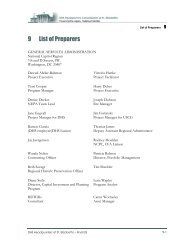395 - GSA Development of St. Elizabeths Campus
395 - GSA Development of St. Elizabeths Campus
395 - GSA Development of St. Elizabeths Campus
- No tags were found...
You also want an ePaper? Increase the reach of your titles
YUMPU automatically turns print PDFs into web optimized ePapers that Google loves.
provide sufficient time for individuals to safely traverse all lanes; these phases constitutemore time in the No-Build scenario than in existing conditions to account for the crosssectionexpansions <strong>of</strong> various approaches at this intersection. The intersectionperformance also adversely impacts the operations <strong>of</strong> the traffic signals located at theramp terminals from the I-295 interchange due to queue spillback. Conversely, thisintersection is also impacted by spillback and congestion associated with the I-295interchange ramps.• Martin Luther King Jr. Avenue at Suitland Parkway ramps – A new at-grade intersectionis constructed on Martin Luther King Jr. Avenue, with ramps merging and divergingwith Suitland Parkway. New weaving movements are introduced within a shortdistance on Suitland Parkway between the intersection with Firth <strong>St</strong>erling Avenue andthe ramps to/from Martin Luther King Jr. Avenue, causing congestion and spillback onSuitland Parkway at the intersections with Firth <strong>St</strong>erling Avenue and the I-295interchange ramp terminals.• Martin Luther King Jr. Avenue at Howard Road – Although operations at thisintersection reflect a reduction in cut-through traffic due to missing movements along I-295, they also reflect an increase in traffic volumes generated by new developmentsalong both roadways and at the Anacostia Metro <strong>St</strong>ation. Similar to the Firth <strong>St</strong>erlingAvenue /Suitland Parkway intersection, the Martin Luther King Jr. Avenue/HowardRoad intersection must balance the competing demands <strong>of</strong> various transport modesincluding transit, pedestrians, and passenger vehicles. The proximity <strong>of</strong> the new signalat the Suitland Parkway ramps limits the amount <strong>of</strong> options available for signal timingimprovements that address excessive queuing and delay.• South Capitol <strong>St</strong>reet at Firth <strong>St</strong>erling Avenue / Defense Boulevard – This intersectionexperiences a significant increase in traffic, owing in large part to the followingconditions: 1) the proposed growth in employment at Anacostia Naval <strong>St</strong>ation / BollingAir Force Base, as well as reallocation <strong>of</strong> gate traffic, results in more trips to and from thegate at Defense Boulevard; and 2) traffic congestion on I-295 results in spillover ontoSouth Capitol <strong>St</strong>reet. During the AM peak, queuing resulting from through traffic onSouth Capitol <strong>St</strong>reet extends south <strong>of</strong> the intersection and beyond the interchange withMalcolm X Avenue. During the PM peak, traffic heading southbound queues up andspills back to the north, through the proposed traffic signal. In addition, traffic on Firth<strong>St</strong>erling Avenue experiences near-gridlock conditions with sizeable queues andincreased travel times.• Suitland Parkway at <strong>St</strong>anton Road – Significant queuing is projected to occur at thisintersection, with spill back sometimes extending to the new ramps from Martin LutherKing Jr. Avenue. Traffic volumes are mainly driven by the increasing demand fromcommuters in the Maryland suburbs to the south and east. Topography and adjacentland use constrain opportunities to address capacity/demand issues.Detailed traffic operation analysis for No Build Alternative is provided in Section 5.5 <strong>of</strong> thisdocument.2-9
















